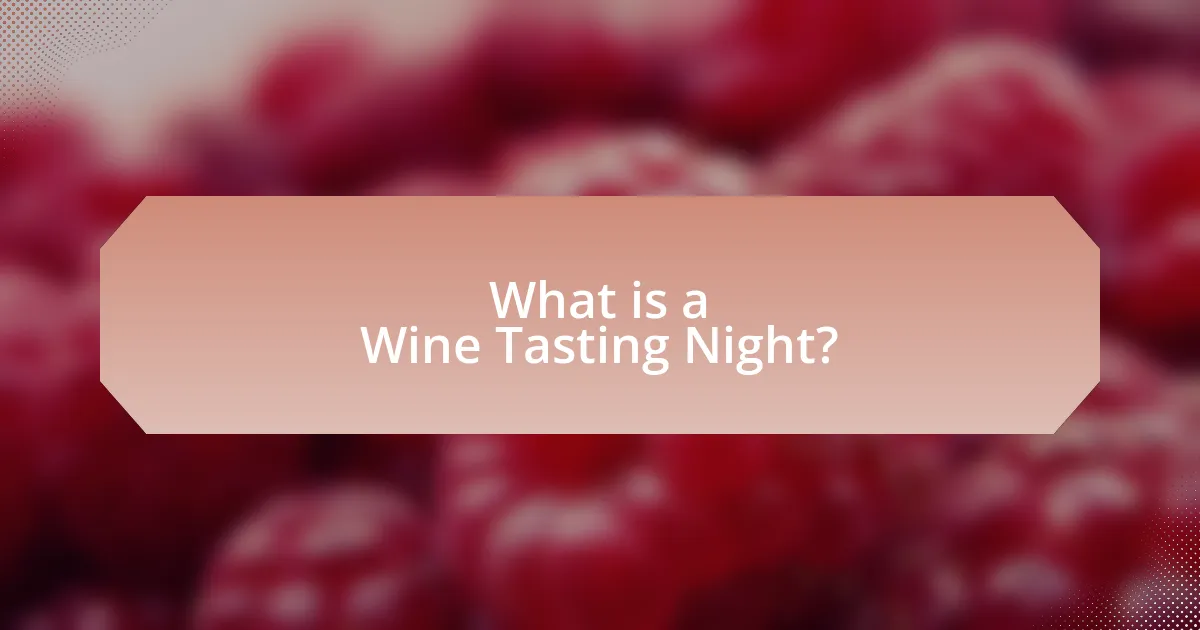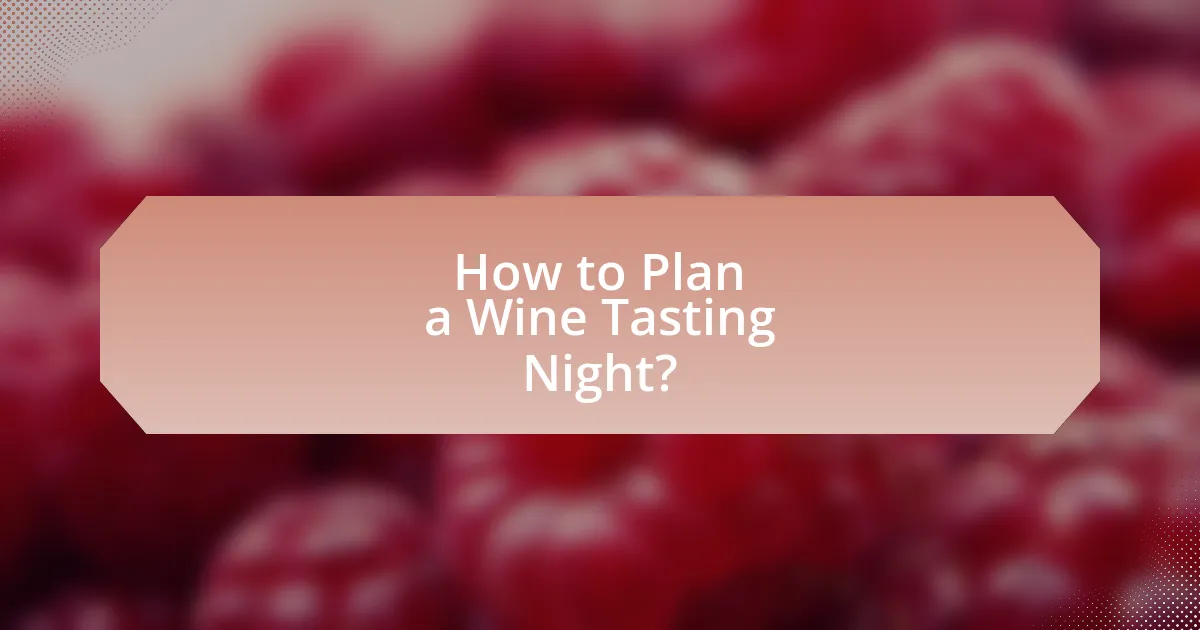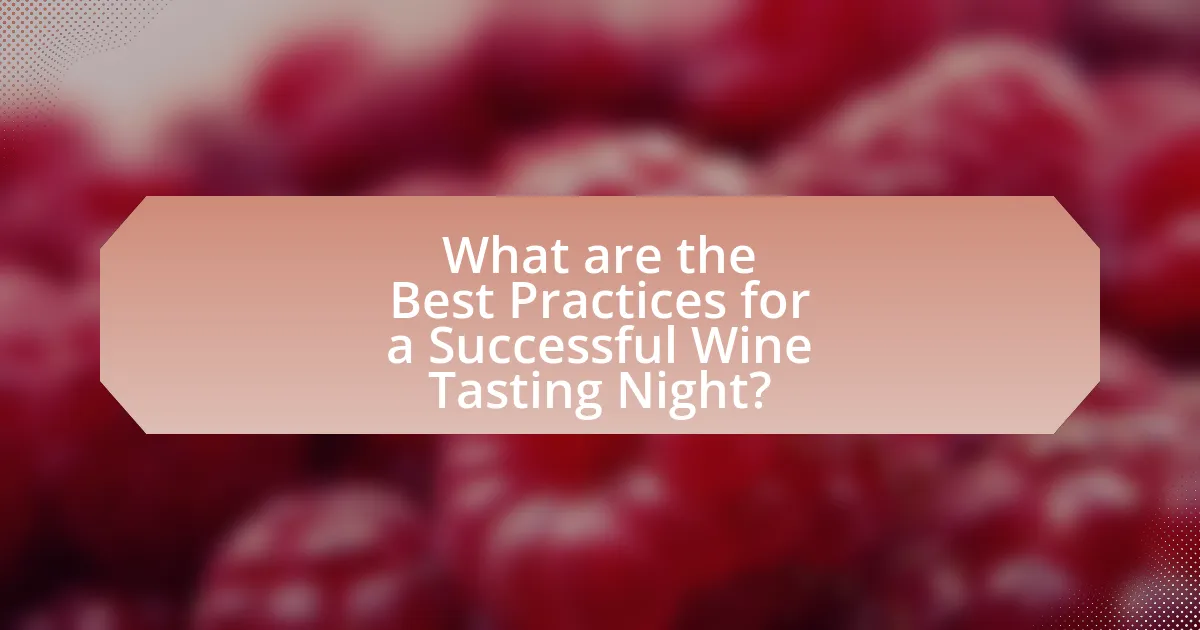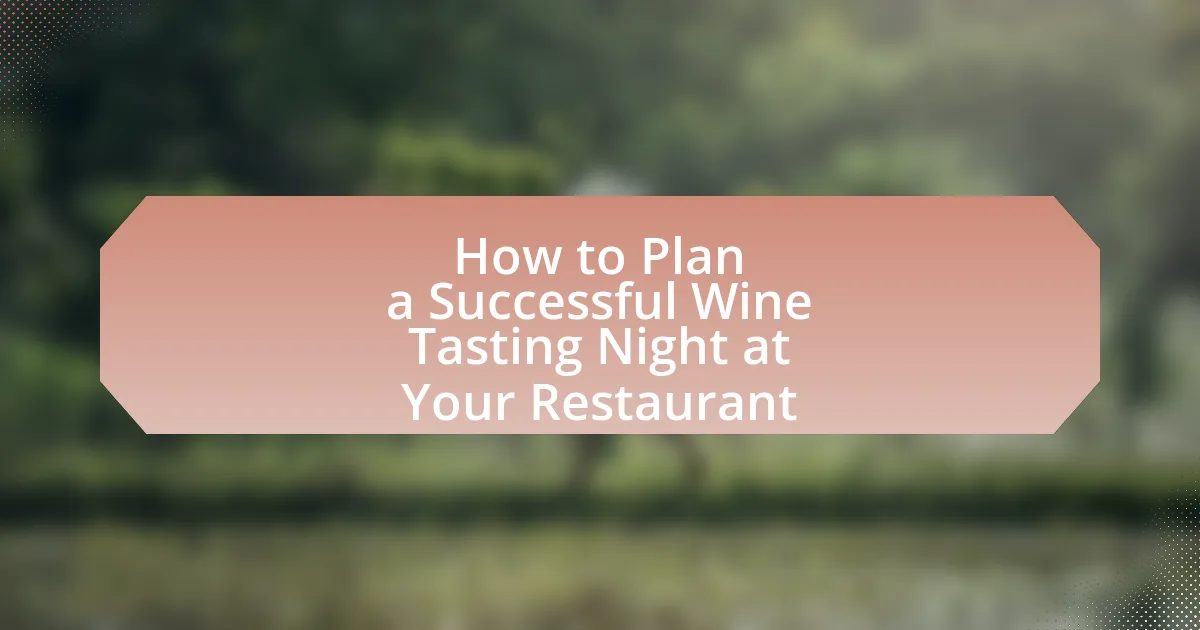A Wine Tasting Night is an event where participants sample and evaluate various wines, often paired with food, enhancing their appreciation and understanding of different wine varieties. This article outlines how to plan a successful Wine Tasting Night at a restaurant, emphasizing the importance of quality wine selection, knowledgeable staff, and an inviting atmosphere. Key elements include effective promotion strategies, the significance of food pairings, and best practices for creating an engaging experience for guests. Additionally, it addresses common challenges and offers practical tips for ensuring a memorable event that fosters customer loyalty and increases revenue.

What is a Wine Tasting Night?
A Wine Tasting Night is an event where participants sample and evaluate various wines, often accompanied by food pairings. This type of gathering allows attendees to explore different wine varieties, learn about their characteristics, and enhance their appreciation for wine. Wine tasting nights typically feature a selection of wines from specific regions or producers, providing an educational experience about the winemaking process and the nuances of flavor profiles.
How does a Wine Tasting Night enhance the dining experience?
A Wine Tasting Night enhances the dining experience by providing guests with an opportunity to explore and appreciate a variety of wines in a social setting. This interactive experience encourages engagement and conversation among diners, fostering a sense of community. Additionally, pairing wines with specific dishes elevates the flavors of both the food and the wine, creating a more memorable culinary experience. Research indicates that wine education during tastings can increase customer satisfaction and loyalty, as diners feel more connected to the dining experience and the restaurant’s offerings.
What elements contribute to a successful Wine Tasting Night?
A successful Wine Tasting Night is primarily influenced by the selection of quality wines, knowledgeable staff, and an inviting atmosphere. Quality wines ensure that guests experience a range of flavors and styles, which enhances their appreciation of the tasting. Knowledgeable staff can provide insights into the wines, including their origins and tasting notes, which enriches the experience for attendees. An inviting atmosphere, characterized by comfortable seating, appropriate lighting, and suitable background music, encourages social interaction and enjoyment among guests. These elements collectively create an engaging and memorable wine tasting experience.
How does the atmosphere impact the Wine Tasting experience?
The atmosphere significantly enhances the wine tasting experience by influencing the sensory perceptions of the participants. A well-designed environment, including lighting, music, and decor, can create a relaxed and inviting ambiance that encourages guests to engage more deeply with the wine. Research indicates that ambient factors, such as soft lighting and pleasant background music, can elevate the enjoyment of wine by affecting taste perception and emotional responses. For instance, a study published in the Journal of Wine Research found that participants rated wines more favorably in environments with warm lighting compared to harsh lighting. This demonstrates that the atmosphere not only sets the mood but also plays a crucial role in how wine is perceived and appreciated.
Why should restaurants host Wine Tasting Nights?
Restaurants should host Wine Tasting Nights to enhance customer engagement and increase revenue. These events attract wine enthusiasts and casual drinkers alike, creating a unique dining experience that encourages patrons to explore new wines and pairings. According to a study by the National Restaurant Association, 70% of consumers are more likely to visit a restaurant that offers special events, such as wine tastings. Additionally, hosting these nights can lead to increased sales of featured wines, as customers often purchase bottles they enjoy during the tasting.
What benefits do Wine Tasting Nights provide for restaurants?
Wine Tasting Nights provide restaurants with increased customer engagement and revenue generation. By hosting these events, restaurants attract wine enthusiasts and create a unique dining experience that encourages patrons to spend more on food and wine pairings. According to a study by the National Restaurant Association, 70% of consumers are more likely to visit a restaurant that offers special events like wine tastings, demonstrating the potential for increased foot traffic and sales. Additionally, these events foster a sense of community and loyalty among customers, as they often return for future tastings and recommend the restaurant to others.
How can Wine Tasting Nights attract new customers?
Wine Tasting Nights can attract new customers by offering unique experiences that engage the senses and create social interactions. These events provide an opportunity for participants to explore diverse wine selections, often paired with gourmet food, which enhances the overall experience and encourages word-of-mouth marketing. According to a study by the Wine Market Council, 60% of wine consumers are more likely to visit a venue that offers wine tasting events, indicating a strong interest in such experiences. Additionally, hosting themed nights or featuring local wineries can draw in community members who are eager to support local businesses, further expanding the customer base.

How to Plan a Wine Tasting Night?
To plan a wine tasting night, first select a date and time that accommodates your target audience, ensuring it does not conflict with other local events. Next, curate a diverse selection of wines, ideally including various regions, varietals, and price points to appeal to different palates. Additionally, create a structured tasting format, such as a guided tasting led by a knowledgeable host, to enhance the experience.
Promote the event through social media, email newsletters, and in-house signage to attract attendees. Finally, consider pairing the wines with complementary food options, as studies show that food can enhance the tasting experience, making it more enjoyable and memorable for participants.
What are the key steps in organizing a Wine Tasting Night?
The key steps in organizing a Wine Tasting Night include selecting a date and time, choosing a theme, curating a wine list, arranging food pairings, promoting the event, and preparing the venue. Selecting a date and time ensures availability for both guests and staff, while choosing a theme, such as regional wines or varietals, adds focus to the tasting experience. Curating a wine list involves selecting a diverse range of wines that complement the theme, and arranging food pairings enhances the tasting experience by highlighting flavors. Promoting the event through social media, email newsletters, and in-house signage increases attendance, and preparing the venue with appropriate seating, glassware, and tasting notes creates a welcoming atmosphere. These steps are essential for a successful Wine Tasting Night, as they ensure a well-organized and enjoyable experience for participants.
How do you select the right wines for the event?
To select the right wines for an event, first assess the theme and purpose of the event, as well as the preferences of the attendees. For instance, if the event is a formal wine tasting, choose a diverse selection of high-quality wines that represent various regions and varietals, ensuring a balance between red, white, and sparkling options. Additionally, consider pairing wines with the food menu to enhance the overall experience; for example, a rich Cabernet Sauvignon pairs well with red meats, while a crisp Sauvignon Blanc complements seafood. Research indicates that offering a range of price points can also cater to different budgets, making the event accessible to a wider audience.
What considerations should be made for food pairings?
Food pairings should consider flavor compatibility, texture contrast, and regional harmony. Flavor compatibility involves matching the intensity and taste profiles of food and wine, such as pairing bold red wines with rich meats. Texture contrast enhances the dining experience; for example, a creamy dish can be complemented by a crisp white wine. Regional harmony suggests pairing local wines with regional dishes, as seen in Italian cuisine where Chianti pairs well with pasta. These considerations enhance the overall tasting experience and ensure that the food and wine complement each other effectively.
How do you promote a Wine Tasting Night effectively?
To promote a Wine Tasting Night effectively, utilize targeted marketing strategies such as social media advertising, email campaigns, and partnerships with local wineries. Social media platforms like Instagram and Facebook allow for visually appealing posts that showcase the wines and atmosphere, reaching a broad audience. Email campaigns can inform existing customers about the event, offering exclusive early-bird tickets or discounts to encourage attendance. Collaborating with local wineries not only enhances the event’s credibility but also taps into their customer base, increasing visibility. According to a study by the Wine Market Council, 60% of wine consumers are influenced by social media, highlighting its effectiveness in event promotion.
What marketing strategies work best for Wine Tasting Nights?
Effective marketing strategies for Wine Tasting Nights include targeted social media promotions, partnerships with local wineries, and email marketing campaigns. Social media platforms like Instagram and Facebook allow restaurants to showcase their events visually, attracting wine enthusiasts. Collaborating with local wineries not only enhances the tasting experience but also leverages their customer base for cross-promotion. Email marketing campaigns can effectively reach existing customers, providing them with exclusive offers and reminders about upcoming events, which can increase attendance. According to a survey by the National Restaurant Association, 60% of consumers are influenced by social media when deciding where to dine, highlighting the importance of these strategies in driving participation in Wine Tasting Nights.
How can social media be utilized to boost attendance?
Social media can be utilized to boost attendance at a wine tasting night by creating engaging content that highlights the event’s unique features and encourages sharing among users. For instance, posting visually appealing images of the wines, food pairings, and the ambiance can attract potential attendees. Additionally, leveraging targeted ads on platforms like Facebook and Instagram can reach specific demographics interested in wine, increasing visibility. According to a study by the Pew Research Center, 69% of adults in the U.S. use social media, making it an effective tool for reaching a large audience. Furthermore, using event countdowns, live updates, and interactive polls can create excitement and anticipation, driving more people to attend.

What are the Best Practices for a Successful Wine Tasting Night?
To ensure a successful wine tasting night, it is essential to select a diverse range of wines that cater to different palates, including whites, reds, and possibly sparkling options. This variety allows guests to explore different flavors and styles, enhancing their overall experience. Additionally, providing detailed tasting notes and background information on each wine can enrich the tasting experience, as it helps participants understand the characteristics and origins of the wines they are sampling.
Setting the right ambiance is also crucial; a comfortable and inviting atmosphere encourages guests to relax and engage in discussions about the wines. Furthermore, pairing wines with complementary food options can elevate the tasting experience, as certain foods can enhance the flavors of the wines.
Finally, limiting the number of wines to a manageable amount, typically between four to six, prevents overwhelming guests and allows for a more focused tasting experience. These best practices are supported by industry standards, which emphasize the importance of variety, education, ambiance, and food pairing in creating memorable wine tasting events.
How can you create an engaging experience for guests?
To create an engaging experience for guests during a wine tasting night, offer a curated selection of wines paired with complementary food options. This approach enhances the sensory experience and encourages interaction among guests. Research indicates that food and wine pairings can elevate the tasting experience by up to 30%, as they stimulate taste buds and create memorable moments. Additionally, incorporating knowledgeable staff to guide the tasting process fosters a deeper understanding of the wines, making the event more informative and enjoyable.
What role does staff training play in the success of the event?
Staff training is crucial for the success of an event, as it directly impacts service quality and guest experience. Well-trained staff can effectively communicate wine selections, provide knowledgeable recommendations, and enhance the overall atmosphere, leading to higher customer satisfaction. Research indicates that events with trained personnel see a 20% increase in positive guest feedback compared to those without adequate training. This correlation highlights the importance of investing in staff training to ensure a memorable and successful wine tasting night at a restaurant.
How can you encourage guest interaction during the tasting?
Encouraging guest interaction during the tasting can be achieved by facilitating open discussions and engaging activities. For instance, prompting guests with questions about their preferences or experiences can stimulate conversation. Additionally, incorporating interactive elements such as blind tastings or food pairings encourages guests to share their thoughts and opinions. Research shows that social interactions enhance the overall experience, making it more memorable and enjoyable for participants.
What common challenges might arise during a Wine Tasting Night?
Common challenges during a Wine Tasting Night include managing guest expectations, ensuring proper wine selection, and maintaining an organized flow of the event. Guest expectations can vary widely, leading to dissatisfaction if the wines do not meet their preferences. Proper wine selection is crucial; offering a diverse range of wines that cater to different palates can be difficult, especially if the selection is limited or poorly matched. Additionally, maintaining an organized flow is essential to keep guests engaged and informed; disruptions or delays can detract from the overall experience. These challenges can impact guest satisfaction and the success of the event.
How can you handle unexpected issues during the event?
To handle unexpected issues during the event, establish a clear communication plan and designate a point person for problem-solving. This approach ensures that any arising issues can be addressed swiftly and efficiently, minimizing disruption. For instance, if a wine shipment is delayed, the designated person can quickly inform guests and offer alternatives, maintaining a positive experience. Research indicates that effective communication during events can enhance guest satisfaction by up to 30%, demonstrating the importance of preparedness in managing unforeseen challenges.
What strategies can mitigate potential guest dissatisfaction?
To mitigate potential guest dissatisfaction during a wine tasting night, restaurants should implement proactive communication, ensure staff training, and provide quality wine selections. Proactive communication involves informing guests about the event details, including the wine selection and tasting process, which sets clear expectations and enhances the experience. Staff training is crucial, as knowledgeable staff can answer questions and guide guests through the tasting, fostering a positive atmosphere. Additionally, offering a curated selection of high-quality wines that cater to diverse palates can significantly enhance guest satisfaction, as evidenced by studies showing that quality offerings lead to higher customer satisfaction ratings in dining experiences.
What are some practical tips for hosting a Wine Tasting Night?
To host a successful Wine Tasting Night, select a variety of wines that cater to different palates, ensuring a mix of red, white, and possibly sparkling options. This variety allows guests to explore different flavors and preferences. Additionally, provide tasting notes for each wine, which can enhance the experience by educating attendees about the characteristics and origins of the wines.
Setting a theme, such as a specific region or grape variety, can also create a cohesive experience and engage guests more deeply. Pairing wines with complementary food items, like cheeses or charcuterie, can elevate the tasting experience and highlight the flavors of the wines.
Finally, limit the number of wines to avoid overwhelming guests; typically, five to seven selections are ideal for a tasting. This approach not only keeps the event manageable but also allows for meaningful discussion about each wine.


